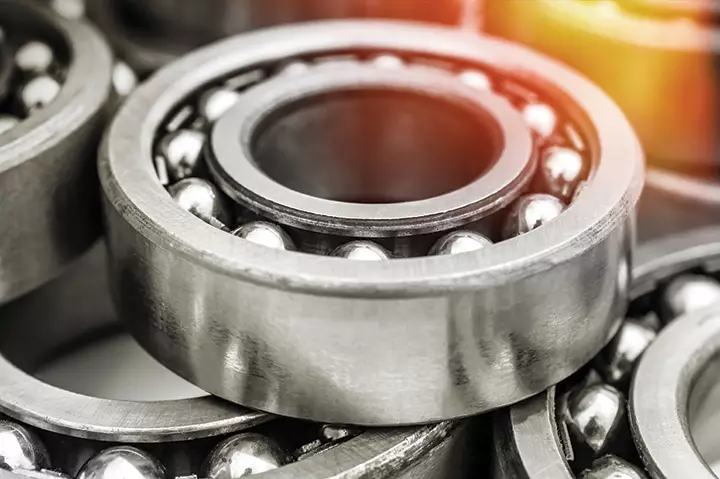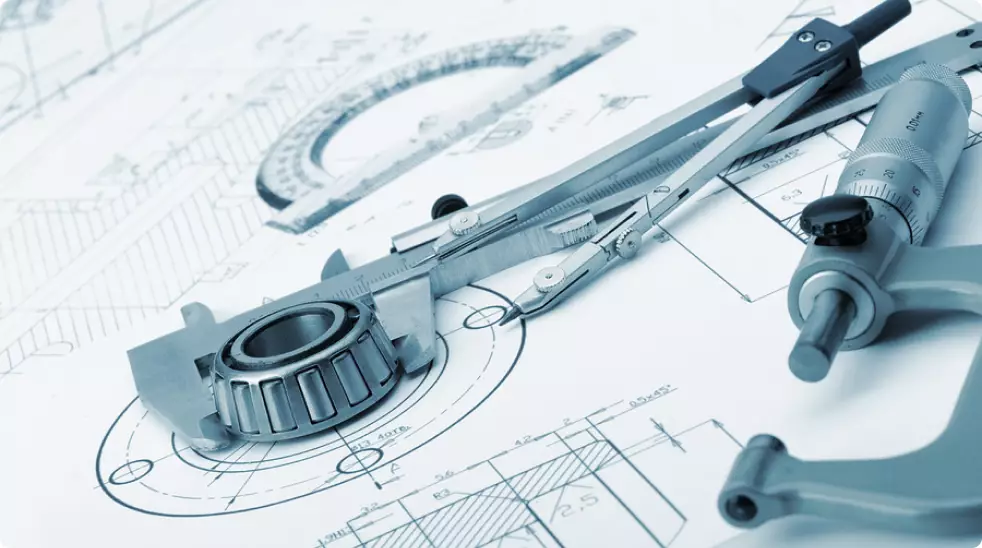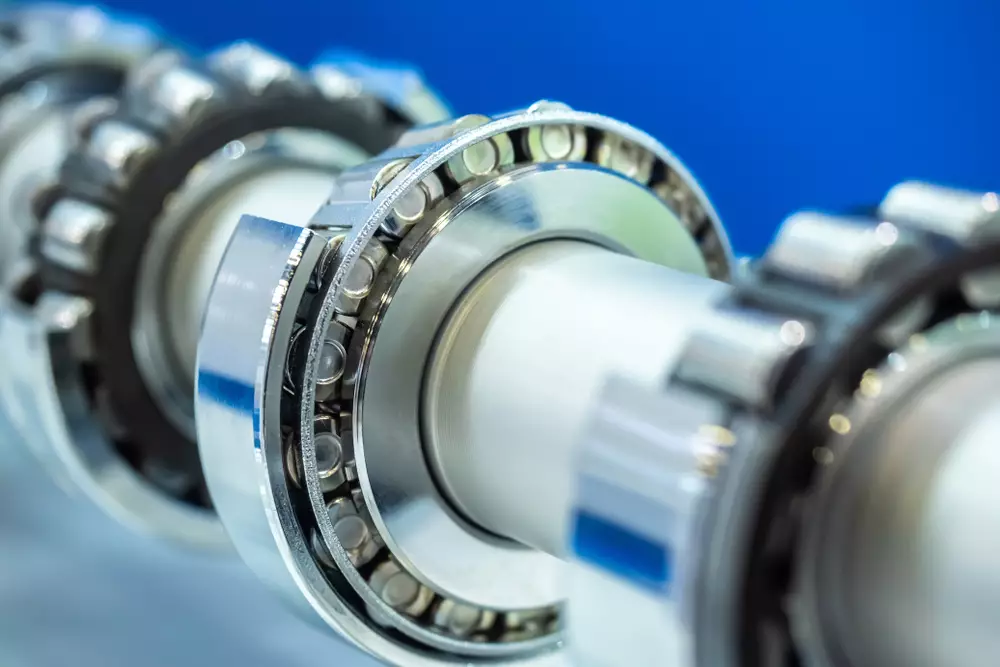
Life calculations for bearings
Calculating the life expectancy of a bearing is a crucial step in mechanical design. It ensures that the selected bearing will last long enough under operating conditions and helps prevent premature failures. Bearing life calculations (such as the L10 rating life) allow engineers to predict how long a bearing can run before fatigue damage occurs, providing confidence in the reliability and maintenance schedule of machinery.
In this guide, we explain how to calculate the standard L10 bearing life (including a step-by-step example), clarify the difference between effective service life and required service life, and outline key factors that influence bearing longevity. A FAQ section at the end answers common questions about bearing life calculations.
How is bearing life (L10) calculated?
Bearing L10 life is calculated using a standard formula that relates the bearing’s load capacity to the applied load. The basic bearing rating life formula is:
L10 = (C/P)^p × 10^6
Where:
- L10 is the calculated bearing life (typically in number of revolutions).
- C is the bearing’s dynamic load rating (capacity, in Newtons).
- P is the applied load on the bearing (in Newtons).
- p is the exponent that depends on bearing type (usually 3 for ball bearings and 10/3 ≈ 3.33 for roller bearings).
This formula yields the bearing’s basic rating life in revolutions (the factor 10^6 is based on one million revolutions as a reference). It represents a 90% reliability life – meaning 90% of identical bearings subjected to load P are expected to last at least L10 revolutions before fatigue failure (only 10% would fail earlier). If the bearing’s operating speed is known, you can convert the calculated revolutions into time: for example, L10 (hours) = L10 (revolutions) / (60 × n), where n is the speed in RPM. The dynamic load rating C is provided by the manufacturer and corresponds to the constant load under which the bearing would statistically achieve 1,000,000 revolutions of life.
Note: If a bearing experiences combined radial and axial loads, first calculate an equivalent load P. This is typically done with P = X·Fr + Y·Fa, where Fr is the radial load, Fa is the axial load, and X and Y are factors (provided by standards or manufacturers) that depend on the bearing type and geometry. Use this equivalent P in the L10 formula. Also, keep in mind that the L10 result is an ideal statistical estimate – real-world factors (such as lubrication, contamination, misalignment, or extreme temperatures) can cause actual bearing life to differ from the calculated value.
Example: Calculating L10 Bearing Life
To illustrate the calculation, let’s walk through a simple example step by step:
Determine the bearing’s dynamic load rating (C). This value comes from the manufacturer.
Example: C = 10,000 N (Newtons).
Determine the actual load on the bearing (P). Use the expected maximum or equivalent load in operation. Example: P = 2,000 N.
Use the appropriate life exponent (p). For ball bearings, p = 3; for roller bearings, p = 10/3.
Example: For a ball bearing, p = 3.
Calculate the ratio (C/P) and raise it to the power p.
Example: C/P = 10,000 / 2,000 = 5.
$(C/P)^p = 5^3 = 125.$
Apply the L10 formula to find the life in revolutions.
L10 = $(C/P)^p × 10^6$
Example: L10 = 125 × 10^6 = 125,000,000 revolutions (i.e. 1.25×10^8 rev).
Convert revolutions to hours (if required) using the bearing’s speed. Divide the total revolutions by the number of revolutions the bearing makes per hour.
Example: Assume the machine runs at 1,000 RPM (revolutions per minute). In one hour, it makes 60,000 revolutions.
L10 (hours) = 125,000,000 rev / 60,000 rev per hour = 2,083 hours (approximately).
In this example, the bearing is expected to last about 2.08×10^3 hours under the given load and speed, which is roughly 87 days of continuous operation. By following these steps with the specific values for your application, you can estimate a bearing’s L10 life and then adjust your design or maintenance plans accordingly.
What is the effective service life of a bearing?
Effective service life is the actual operational lifespan a bearing achieves under real conditions before it fails or needs replacement. In other words, it’s how long the bearing actually lasts in service, which may be shorter or longer than the calculated rating life depending on usage and care. The effective service life is typically measured in hours of operation, number of revolutions, or work cycles that the bearing endures while functioning properly.
A bearing’s effective life is influenced by the actual operating conditions it experiences, including loads, speeds, lubrication quality, alignment, and environmental factors. Engineers often use the L10 rating life calculation (adjusted for the bearing’s real load and speed conditions) as one way to estimate the probable service life. For instance, by inputting the expected field load and speed into the life formula, you get a baseline estimate of how long the bearing might last. In practice, a bearing is considered to have reached the end of its effective life when signs of fatigue or wear appear (e.g. material flaking on the raceways or rolling elements, excessive vibration, etc.), indicating impending failure.
Importantly, good maintenance can extend a bearing’s effective service life. Regular lubrication, proper installation, and periodic inspections help prevent premature failures. Many bearings outlast their predicted life if they are kept clean, cool, well-lubricated, and free from overloads. In fact, with ideal conditions and care, a bearing’s effective life can sometimes exceed the originally required service life for the application.
What is the required service life of a bearing?
Required service life is the minimum lifespan a bearing is expected to achieve to meet the needs of a specific application. This is essentially the target life set by the machine designer or end user, usually defined in terms of operating hours, total revolutions, or years of service. The required service life represents how long the bearing needs to last (without failure) for the machine to perform reliably and meet maintenance or warranty criteria.
In practice, engineers specify a required life based on factors like the machine’s intended overall life, maintenance intervals, and reliability goals. For example, a designer might require a bearing to have a service life of at least 20,000 hours (about 2.3 years of continuous operation) for a given application. The bearing selected must have a calculated L10 life that meets or exceeds this requirement under the expected operating conditions.
To ensure a bearing will reach its required service life, the design must account for all the factors that influence bearing longevity. Factors such as load, speed, lubrication, environment, and maintenance must be managed so that the bearing isn’t overstressed. By controlling these factors (e.g. not exceeding the bearing’s load capacity, providing adequate lubrication, protecting against contamination, and servicing the bearing on schedule), the bearing is more likely to achieve or surpass its required life. In the next section, we detail these key factors affecting bearing life.
What factors affect bearing life?
Several key factors have a major impact on bearing life, including the applied load, operating speed, lubrication, environmental conditions, and maintenance practices. If any of these are unfavorable, the bearing’s actual life will shorten; if they are well-managed, the bearing can achieve a longer life. The main factors are:
- Load: Heavier loads accelerate bearing fatigue. A bearing operating close to or above its design load capacity (C) will have a much shorter life. Keeping the applied load low relative to C greatly increases life. (Every reduction in load has a dramatic positive effect on life, due to the exponential relationship in the L10 formula.)
- Speed: High rotational speeds can shorten bearing life. Faster speeds generate more friction heat and can push lubrication to its limits, leading to wear. Exceeding the bearing’s recommended speed (often given by a limiting speed factor) will reduce life. In general, the higher the RPM, the fewer hours a bearing may last, unless specially designed for high speed.
- Lubrication: Proper lubrication is critical for bearing longevity. Inadequate or degraded lubricant increases friction and wear between rolling elements and races, dramatically reducing life. Using the correct type of lubricant in the right amount – and replenishing it at intervals – helps prevent metal-to-metal contact and dissipates heat, thus extending the bearing’s life.
- Operating environment: Harsh conditions will shorten a bearing’s life. For example, high or low temperatures outside the bearing’s range can degrade lubrication or materials; contaminants like dirt, dust, or moisture can infiltrate and cause abrasion or corrosion. A clean, controlled environment allows bearings to reach their full life potential, while dirty or extreme environments require special seals, coatings, or more frequent maintenance to mitigate damage.
- Maintenance: Lack of maintenance leads to premature bearing failure. Routine inspection, cleaning, and re-lubrication can greatly extend bearing life by catching issues early and ensuring optimal conditions. Misalignment or improper installation can also reduce life, so proper mounting and alignment are part of good maintenance. Regular maintenance helps a bearing achieve or even exceed its expected service life, whereas neglect will almost certainly shorten it.
Note: At very high speeds, engineers use a concept called the speed factor (n × dm) to evaluate a bearing’s suitability. This factor is the product of the operating speed n (in RPM) and the bearing’s mean diameter dm (in mm), and it gives an indication of how challenging the lubrication and heat dissipation conditions are. A high n × dm value means the bearing is in a high-speed regime, which may require special high-speed grease, precision bearings, or de-rating of the bearing’s load capacity to ensure reliable life. Always consult manufacturer guidelines for high-speed applications – they may provide adjusted life calculations or limits for when standard life formulas need correction.
Having considered these factors, you can see that bearing life is not a fixed number but rather a result of both the bearing’s design (capacity, quality) and how it is used. By managing loads and speeds, keeping bearings well-lubricated and clean, and performing regular maintenance, you give the bearing the best chance to reach its required service life or beyond.
Still have a question or need to discuss something? Contact us to get help.
Frequently Asked Questions (FAQs)
How do you calculate the L10 life of a bearing?
You calculate a bearing’s L10 life using the formula L10 = (C/P)^p × 10^6, where C is the bearing’s dynamic load rating, P is the applied load, and p is the life exponent (3 for ball bearings, 10/3 for roller bearings). Plug in those values to get the bearing life in number of revolutions. For example, if a bearing’s capacity C is 10,000 N and the load P is 2,000 N (with p = 3), then L10 = (10000/2000)^3 × 10^6 ≈ 125×10^6 revolutions. If the bearing runs at a given RPM, you can convert this to hours of operation (by dividing revolutions by revs per hour).
What does L10 bearing life mean?
L10 life (also called B10 life) is a statistical measure of bearing longevity. It represents the time or number of revolutions at which 90% of identical bearings will still be running without failure under specific conditions (conversely, 10% may have failed by that point). In other words, L10 is the bearing life associated with 90% reliability. It’s a standard used by bearing manufacturers to characterize fatigue life.
What is the difference between required service life and effective service life?
Required service life is the target lifespan a bearing is specified to achieve for an application, whereas effective service life is the actual lifespan the bearing achieves in practice. The required life is determined during design – it’s how long the bearing needs to last (often set by machine requirements or maintenance schedules). The effective life is measured during operation – it’s how long the bearing actually lasts under real conditions. Ideally, the effective service life meets or exceeds the required service life, but if operating conditions are worse than expected (or maintenance is poor), the effective life could be shorter.
What factors affect the life of a bearing?
The main factors that affect bearing life are load, speed, lubrication, environment, and maintenance. Heavier loads or higher speeds will shorten a bearing’s life (due to increased stress and heat). Poor or insufficient lubrication leads to more friction and faster wear, drastically reducing life. Harsh environmental conditions (such as high temperatures, dirt, moisture, or vibration) can also cause early bearing failure. On the other hand, careful maintenance – including proper lubrication, keeping contaminants out, correct installation, and regular inspections – will help a bearing last longer.
How can I extend the service life of a bearing?
To extend a bearing’s life, focus on good lubrication and maintenance practices. Use the correct lubricant and keep it fresh – replenish or change oils/grease on the recommended schedule. Avoid overloading the bearing beyond its capacity and do not exceed its speed ratings. Keep the bearing and its surroundings clean to prevent dirt or debris from causing damage (use seals or filters in dirty environments). Ensure proper installation and alignment of the bearing to avoid undue stresses. By reducing loads, limiting excessive speed, keeping the bearing well-lubricated, and performing regular inspections/maintenance, you can significantly increase the bearing’s service life and prevent premature failures.
Why is the life formula exponent different for ball vs. roller bearings (3 vs 10/3)?
The life equation’s exponent p differs because ball bearings and roller bearings contact surfaces in different ways, affecting how load influences fatigue. Ball bearings (point contact) follow an approximately cubic relationship between load and life, so p = 3 is used. Roller bearings (line contact) are slightly less sensitive to load, and empirical testing has shown an exponent of 10/3 (≈3.33) fits their fatigue behavior. These values are established in bearing industry standards (like ISO 281) to account for the geometry of the contact – essentially, roller bearings can carry more load for the same life compared to ball bearings, hence the lower exponent in the formula.


